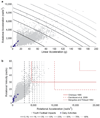An envelope of linear and rotational head motion during everyday activities
- PMID: 31786677
- PMCID: PMC7210075
- DOI: 10.1007/s10237-019-01267-6
An envelope of linear and rotational head motion during everyday activities
Abstract
Various studies have characterized head kinematics in specific everyday activities by looking at linear and/or rotational acceleration characteristics, but each has evaluated a limited number of activities. Furthermore, these studies often present dissimilar and sometimes incomplete descriptions of the resulting kinematics, so the characteristics of normal everyday activities as a whole are not easily collectively summarized. The purpose of this study was to evaluate the literature investigating head kinematics associated with everyday activities and to generate a comprehensive kinematic boundary envelope describing these motions. The envelope constructed constitutes the current state of published knowledge regarding 'normally occurring' head accelerations. The envelope of kinematics represents activities commonly encountered and posing zero to minimal risk of injury to healthy individuals. Several kinematic measures, including linear accelerations, rotational velocities, and rotational accelerations, one may encounter as a result of normal everyday activities are summarized. A total of 11 studies encompassing 49 unique activities were evaluated. Examples of activities include sitting in a chair, jumping off a step, running, and walking. The peak resultant linear accelerations of the head reported in the literature were all less than 15 g, while the peak resultant rotational accelerations and rotational velocities approach 1375 rad/s2 and 12.8 rad/s, respectively. The resulting design envelope can be used to understand the range of acceleration magnitudes a typical active person can expect to experience. The results are also useful to compare to other activities exposing the head to motion or impact including sports, military, automotive, aerospace and other sub-injurious and injurious events.
Keywords: Brain injury; Daily head accelerations; Finite element model; Kinematics; Strain.
Conflict of interest statement
Conflict of Interest: The authors declare that they have no conflict of interest.
Figures







Similar articles
-
The effect of gender and body size on linear accelerations of the head observed during daily activities.Biomed Sci Instrum. 2006;42:25-30. Biomed Sci Instrum. 2006. PMID: 16817580 Clinical Trial.
-
An Instrumented Mouthguard for Real-Time Measurement of Head Kinematics under a Large Range of Sport Specific Accelerations.Sensors (Basel). 2023 Aug 10;23(16):7068. doi: 10.3390/s23167068. Sensors (Basel). 2023. PMID: 37631606 Free PMC article.
-
Evaluation of a coplanar 6a3ω configuration in the Hybrid III 50th percentile male head.Traffic Inj Prev. 2017 May 29;18(sup1):S129-S135. doi: 10.1080/15389588.2017.1318210. Traffic Inj Prev. 2017. PMID: 28399658
-
Characterizing Exposure to Head Acceleration Events in Youth Football Using an Instrumented Mouthpiece.Ann Biomed Eng. 2022 Nov;50(11):1620-1632. doi: 10.1007/s10439-022-03097-7. Epub 2022 Oct 23. Ann Biomed Eng. 2022. PMID: 36274103 Free PMC article.
-
Use of Brain Biomechanical Models for Monitoring Impact Exposure in Contact Sports.Ann Biomed Eng. 2022 Nov;50(11):1389-1408. doi: 10.1007/s10439-022-02999-w. Epub 2022 Jul 22. Ann Biomed Eng. 2022. PMID: 35867314 Free PMC article. Review.
Cited by
-
Quantification of Head Acceleration Events in Rugby League: An Instrumented Mouthguard and Video Analysis Pilot Study.Sensors (Basel). 2022 Jan 13;22(2):584. doi: 10.3390/s22020584. Sensors (Basel). 2022. PMID: 35062545 Free PMC article.
-
Relationship between experience and head kinematics in race riding jockeys.Sci Rep. 2025 Apr 26;15(1):14686. doi: 10.1038/s41598-025-98683-9. Sci Rep. 2025. PMID: 40287497 Free PMC article.
-
The Influence of Induced Head Acceleration on Lower-Extremity Biomechanics during a Cutting Task.Sensors (Basel). 2024 Aug 3;24(15):5032. doi: 10.3390/s24155032. Sensors (Basel). 2024. PMID: 39124078 Free PMC article.
-
A Systematic Review of Head Impacts and Acceleration Associated with Soccer.Int J Environ Res Public Health. 2022 May 1;19(9):5488. doi: 10.3390/ijerph19095488. Int J Environ Res Public Health. 2022. PMID: 35564889 Free PMC article.
-
Immediate and Transient Perturbances in EEG Within Seconds Following Controlled Soccer Head Impact.Ann Biomed Eng. 2024 Oct;52(10):2897-2910. doi: 10.1007/s10439-024-03602-0. Epub 2024 Aug 13. Ann Biomed Eng. 2024. PMID: 39136891
References
-
- Allen ME, Weir-Jones I, Eng P, et al. (1994) Acceleration Perturbations of Daily Living: A Comparison to’Whiplash’. Spine 19:1285–1290 - PubMed
-
- Bussone (2005) Linear and Angular Head Accelerations in Daily Life. Virginia Polytechnic Institute and State University
-
- Bussone WR, Duma SM (2009) The effect of gender and body size on angular accelerations of the head observed during everyday activities-biomed 2010. Biomed Sci Instrum 46:166–171 - PubMed
MeSH terms
Grants and funding
LinkOut - more resources
Full Text Sources

